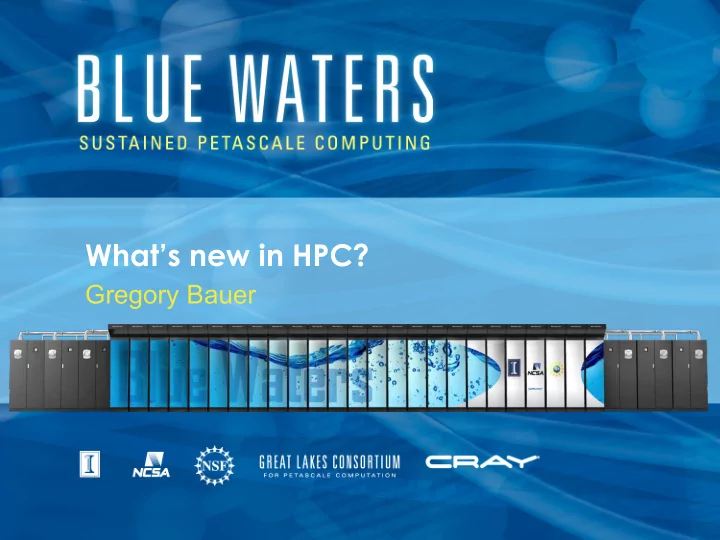

What’s new in HPC? Gregory Bauer
To keep up-to-date on HPC • HPC Guru - https://twitter.com/HPC_Guru • Glenn Lockwood - http://www.glennklockwood.com/ • http://www.nextplatform.com 2
What’s old is new again? All aspects of HPC are (again) rapidly changing. • Return of Ethernet to HPC • Revisiting (relaxed) POSIX I/O semantics • New accelerators • New CPUs 3
HPC in the US NSF and DOE • NCSA Blue Waters (AMD CPU and NVIDIA GPU) 2013 14 PF • ORNL Titan (AMD CPU and NVIDIA GPU) 2012 27 PF • NERSC Cori (Intel Xeon Phi) 2016 28 PF • ANL Theta (Intel Xeon Phi) 2017 12 PF • TACC Stampede2 (Intel Xeon Phi and Intel CPU) 2017 18 PF • ORNL Summit (IBM P9 + NVIDIA V100) 2018 200 PF • LLNL Sierra (IBM P9 + NVIDIA V100) 2018 125 PF • TACC Frontera (Intel CPU + GPU) 2019 35-40 PF • NERSC Perlmutter (AMD EPYC + Nvidia GPU) 2020 100 PF • ANL Aurora (Intel CPU and Xe GPU) 2021 1 EF • ORNL Frontier (AMD EPYC Zen 4 and Radeon GPU) 2022 1.5 EF Commercial HPC • DUG McCloud (Xeon Phi) 2019 125 PF (DP) 4
Changes to the landscape • Mergers & Acquisitions • HPE • CRAY – accelerator OpenMP support • Long history: Convex, Compaq (DEC/Alpha), SGI, … • NVIDIA • Mellanox • PGI (2013) – OpenACC support • Intel • Altera FPGA (2015) • “New” integrator • DownUnder Geosolutions 5
Changes to the landscape • ARM (Softbank) • Fujitsu A64FX • Marvell (Cavium) ThunderX2 • Intel • Xe GPU • Google • TPU • Tachyum • Prodigy CPU 6
CPU peak feeds and speeds clock rate FP64 rate Memory Bytes/flop Vendor/Processor cores/node (GHz) (TFLOPS) Bandwidth (TB/s) ratio Notes AMD Interlagos 2x8 2.3 0.313 0.102 0.33 Intel Sandybridge 2x8 2.6 0.333 0.102 0.31 Intel Skylake 2x20 2.4 3.07 0.256 0.08 ARM ThunderX2 2x32 2.1 1.13 0.32 0.28 NEON Intel Cascade Lake 2x28 2.1 3.76 0.282 0.08 AVX 512 AMD Rome 2x64 1.7 3.5 0.380 0.11 AVX2 16 FP/clock Fujitsu ARM A64FX 2x48 ? 2.7 2 0.7 4 SVE 512 , HBM2 Tachyum Prodigy 2x64 ? 8 0.614 0.08 DDR5 4800 512 bit vector 4 inst/clock Intel Ice Lake 7
Benchmarketing AMD says Intel says 8
Thunderx2 on Cray XC50 Isambard OpenMulti-node Scaling OpenFOAM Single node performance Simon McIntosh-Smith – U Bristol, GW4, Isambard Comparative Benchmarking of the First Generation of HPC-Optimised Arm Processors on Isambard CUG 2018 Scaling Results From the First Generation of Arm-based Supercomputers CUG2019 9
Hardware factors • Cache speed • AMD and ARM are typically slower than Intel; impacting strong scaling. • Memory bandwidth • 8 channels (ARM) better than 6. • Vector widths • Intel vector wider but at a clock speed cost • ARM SVE catching up 10
GPUs • NVIDIA Ampere • Better than V100 • V100 performance • 7.5/15/120 TF (DP/SP/HP) 900 GB/s 16 GB HBM2 • AMD Radeon Instinct • 6.7/13.4/26.8 TF (DP/SP/HP) 1 TB/s 16 GB HBM2 • Intel GPU (Xe) • not much generally available 11
Software • Now need to support 3 GPUs (NVIDIA, AMD, Intel) • Possibly 3 different vector engines • “frameworks” like Kokkos, Raja, etc. can provide portability and performance for CPU, GPU targets. • Intel “OneAPI” • AMD ROCm, HIP 12
Software • Compiler performance with TSVC loop suite • 151 loops • Blue Waters • Intel Skylake Evaluating Compiler Vectorization Capabilities on Blue Waters, CUG2019 13
Quantum Computing • Disruptive technology at SC’07 • D-Wave, Fujitsu, Google, Honeywell, Lockheed-Martin, Microsoft, NEC, Toshiba, … • Various ways to provide qubits: trapped ions, quantum dots, superconductors, .. • ”Proven” for certain types of problems: encryption, discrete event modeling, … • Accessible via cloud computing with various SDKs etc. 14
Things to play with • Google Edge TPU – only runs TensorFlow lite for inference currently but … • https://www.sparkfun.com/products/15318 $156.95 15
Current trend • Additional tiers • NVMe > SSD > Spinning disk > ??? • I/O Accelerators • Burst buffers 16
One view about changes to storage https://insidehpc.com/2019/04/long-live-posix-hpc-storage-and-the-hpc-datacenter/ 17
Recommend
More recommend